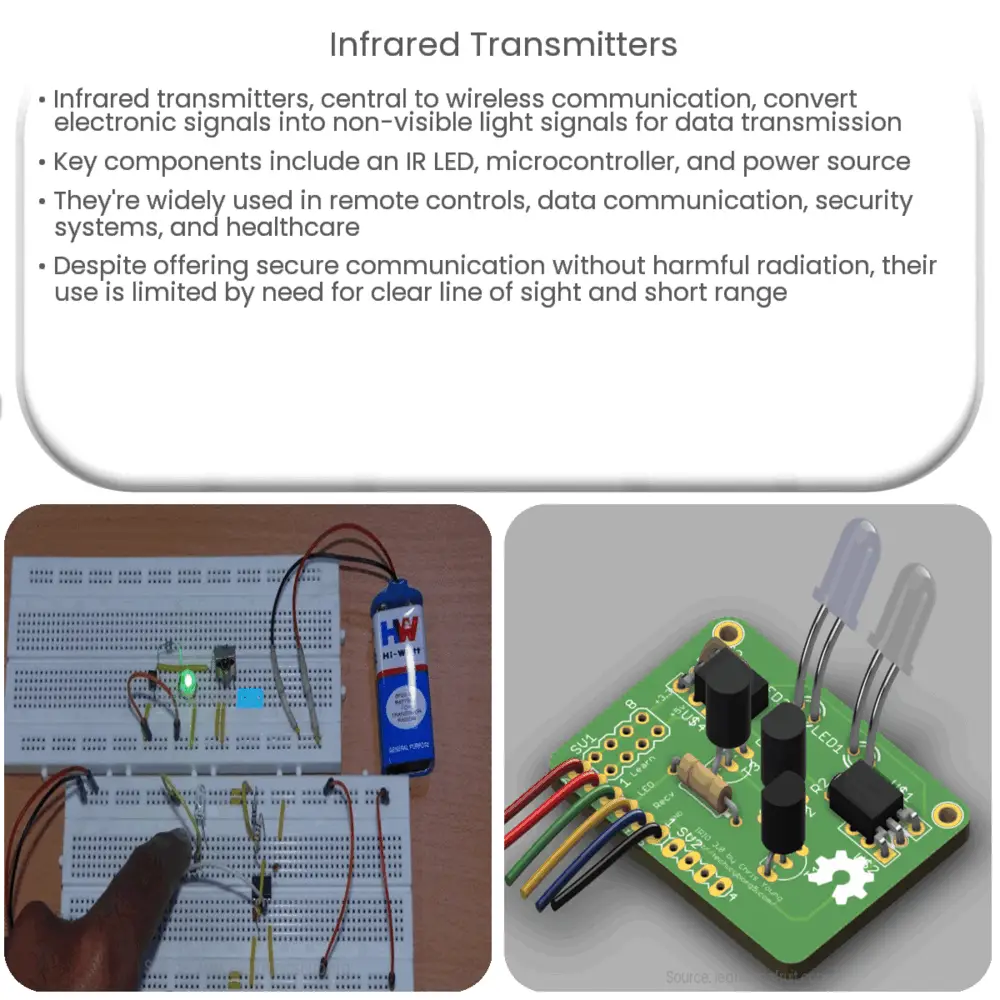Explore the world of infrared transmitters: their working principle, key components, applications, advantages, and limitations.

Infrared Transmitters: An Insight into Invisible Communication
In the universe of communication technologies, Infrared Transmitters play a significant yet unobtrusive role. Leveraging the power of infrared light, they form an integral part of many everyday devices, enabling seamless and wireless data transmission.
Understanding Infrared Transmitters
An Infrared Transmitter (IR Transmitter) is a hardware device that uses infrared radiation to transmit signals. At its core, the transmitter modulates the data signal with an infrared light signal. In essence, it converts electronic signals into non-visible light signals, which are then sent out in the environment.
Working Principle of Infrared Transmitters
The operating principle of an infrared transmitter is quite straightforward. It begins with the transformation of electrical energy into light energy. This process occurs in a small semiconductor device known as an LED (Light Emitting Diode). These LEDs emit light in the infrared region when electrical current is passed through them.
Interestingly, the emitted light is not visible to the naked eye as it falls outside the visible light spectrum. However, the light is detectable by certain electronic sensors, allowing the encoded information to be received by the appropriate device.
Components of an Infrared Transmitter
- IR LED: This is the heart of the infrared transmitter. It is responsible for emitting infrared light when electrical current passes through it.
- Microcontroller: This component is crucial as it assists in data processing and modulation. Essentially, it helps in controlling the pulse width and pulse rate, which are key to proper data transmission.
- Power Source: An adequate power source is required to drive the entire system. This usually takes the form of a battery in most portable devices.
- Resistors, Capacitors, and Other Electronic Components: These additional elements ensure the stable and efficient operation of the transmitter.
With this fundamental understanding of infrared transmitters, let’s delve deeper into the numerous applications and advantages of this technology in our next section.
Applications of Infrared Transmitters
Due to their compact size, low power requirements, and effectiveness, Infrared Transmitters have found their way into a wide range of applications:
- Remote Control Devices: One of the most common uses of infrared transmitters is in remote control devices for TVs, DVD players, and air conditioners. The buttons on the remote send different pulse patterns of infrared light to the receiver in the device, allowing the user to control it wirelessly.
- Data Communication: Infrared transmitters are used for short-range data communication in devices such as printers, keyboards, and mice, as well as for data transfer between mobile devices.
- Security Systems: Infrared transmitters and receivers are used in security systems to detect movement. When the infrared light beam is interrupted, the system triggers an alarm.
- Healthcare: In medical science, infrared thermometers and pulse oximeters use infrared transmitters to measure body temperature and oxygen saturation in the blood respectively.
Advantages and Limitations
Infrared technology comes with its set of advantages and limitations. On the plus side, it provides secure communication as the data cannot penetrate through walls. Furthermore, there’s no risk of harmful radiation or interference with other devices.
However, it also has its limitations. Infrared communication requires a clear line of sight and is limited to short distances. Furthermore, it can be affected by strong light sources and certain weather conditions.
Conclusion
In conclusion, infrared transmitters represent a vital cog in the wheel of wireless communication technologies. While they may have their limitations, the wide array of applications they serve, from the remote control sitting on your couch to the sophisticated security systems guarding facilities, is a testament to their importance. As technology evolves, we can expect infrared transmitters to adapt and continue playing a pivotal role in our daily lives.

